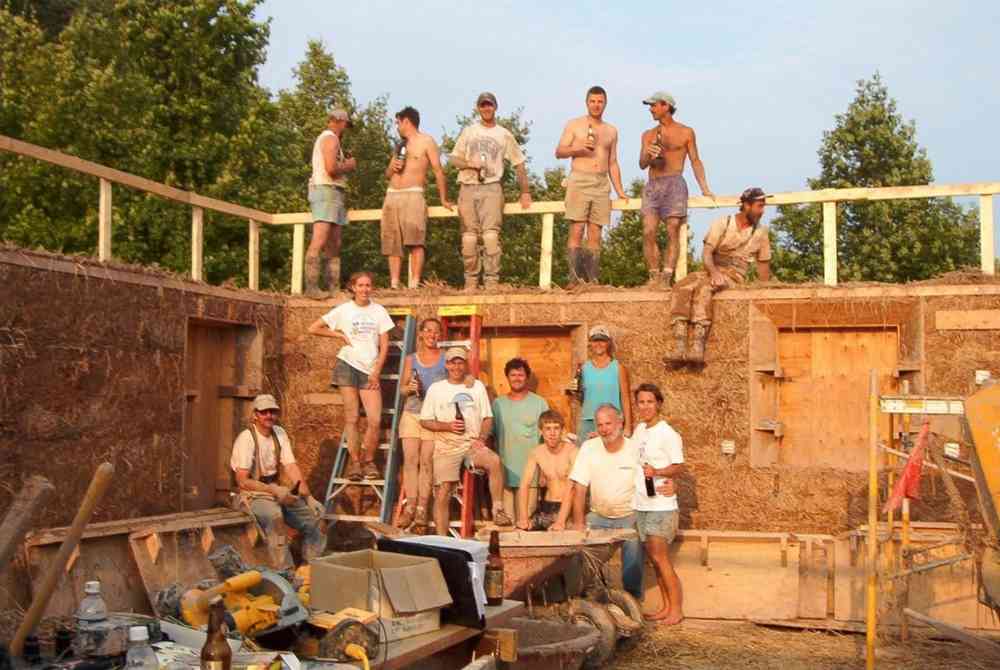News
Telford Farm: An Intentional Community in Cedar, MI
November 10, 2020

Kate Fairman, affiliate professor of integrative, religious, and intercultural studies (IRIS), has worked part-time for the IRIS department since 2007 and served as the advisor for integrative studies students at the GVSU Traverse City Regional Center. Kate lives on a shared farm in northern Michigan with her husband, Bill, and her three children, Clayton, Lucy, and Tamanna. This month, we spoke with Kate about the farm's history and her experience there.
What is Telford Farm and how was it started?
Telford Farm is an intentional community in Cedar, MI. It
currently consists of 9 families who share a vision and ownership of
80 acres of rural land in Leelanau county. In 1998, a neighbor invited
us to walk a piece of property that his colleague was intrigued by,
but knew she could not purchase on her own. Word spread and about
15-20 people showed up to walk the land. In reaching the ridge top, it
was not hard to fall in love with the view and we immediately saw the
potential of building a small community.
Soon after, an offer by another party was put in on the property, which meant that it was a ‘do or die’ prospect for our group that had gathered. Our small group met for an afternoon and we outlined a vision for a community and joint purchase. A couple people bowed out when their vision did not match the majority who had gathered, and in the end, seven families were committed to moving forward with an offer. Obviously, our offer was accepted and we purchased the property as an LLC and immediately started to meet creating a clustered development with common space all around it.
What drew you to create this community?
As it happened, I had previously been drawn to the concept of
intentional communities, or co-housing as they’re sometimes called. I
had travelled for a few months in New Zealand, where I participated in
the network, Willing Workers on Organic Farms (WWOOF), and had stayed
at a few intentional communities that had farm operations. This
concept intrigued me and also led to my awareness of these communities
all over the world. There is a fabulous directory of communities at ic.org.
What are the advantages and challenges of living and working
together in this type of community?
One of the greatest blessings has been raising my children in a
place where they have had free range and have been fully embraced by a
community with common interests. None of the community members are
full-time farmers, but we all have an interest in sustainable
practices, so we have experimented with things such as raising
animals — chickens, pigs, cows, goats. When we had a cow, our family
did the milking one morning per week and now each of my kids can milk
a cow!
We also initially ran a commercial vineyard that existed on the property when we purchased it. For a decade, we pruned, tied grapevines, and held a harvest party where sometimes 100 friends and family would show up to help harvest grapes, followed by a party. These are just a couple examples of learning opportunities that my family never would have had or tried on our own. We also learned that some of these practices are challenging to maintain. Our vineyard, for instance, was hit with a couple harsh winters and we were not able to maintain the effort and inputs needed to revive it. Uniting and maintaining a particular effort can be challenging for any community.
How does your research and teaching at GVSU intersect with
your life and work on the farm?
I studied environmental behavior and one thing we know is that
behavior change is difficult. The problem-solving approach of “small
experiments,” trying something small with lower stakes, is a great way
to promote new behaviors. Moreover, having the support of a small
community to try different initiatives, such as raising a few pigs,
planting blueberries, removing invasive species, or implementing
renewal energy seems to significantly enhance our willingness to
experiment with different practices. Another example of something my
family would not have done without the experimentation of a small
group is to build a house using straw-clay construction; four houses
in our community are built with straw-clay walls. This sort of life
experience intersects very well with courses I teach, like “Wicked
Problems in Sustainability,” a course where small groups of students
engage with similar types of experimentation to promote sustainable
practices in the community
And can we visit? It must be beautiful up there right now!
Absolutely, you can visit. We don’t have any formal process for
visitors, but anyone can contact
me to come and check things out
